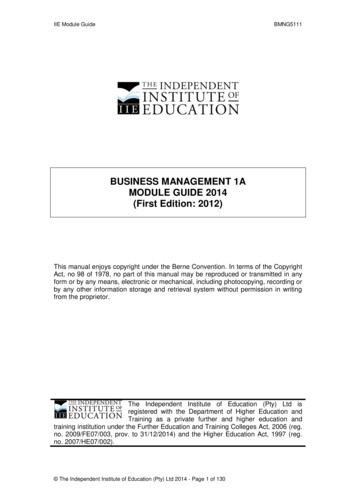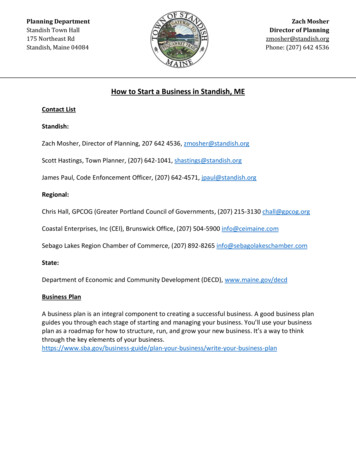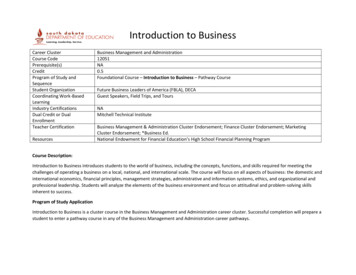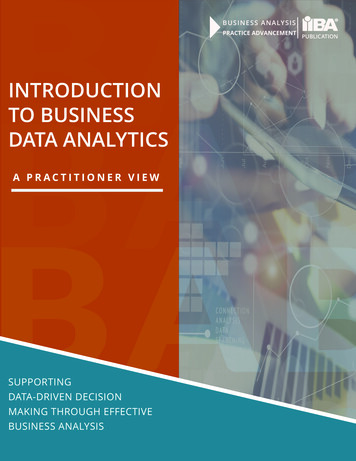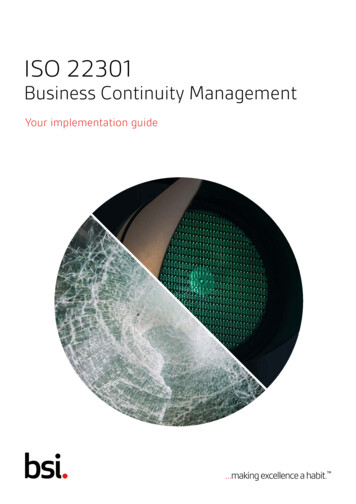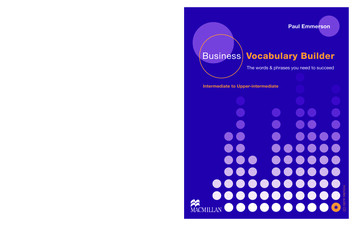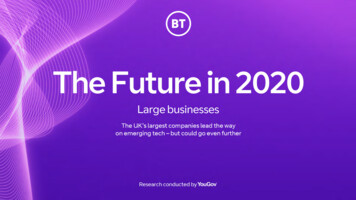
Transcription
Introduction12
New technologies willtransform businessesof all shapes and sizes.Right now in the UK,large businesses areleading the way.We worked with YouGov to survey1,006 business leaders from acrossthe country.Specifically we asked about 14 innovative technologies(see full list on page 19) that can change the way businessesoperate. Which of these do they use? Which might they use?And how will they decide?The largest companies (1,000 employees) are more awareof these technologies and most likely to be using them. Thisbrings clear commercial advantages as emerging tech helpsthem pursue their main objectives, from increasing revenueand reducing costs to boosting productivity and creating newcustomer experiences.But our survey also flags up a few warnings. Large businessesare struggling to recognise the full benefits of emergingtechnology. There are big variations between differentindustries. And large companies still need convincing howsome of these technologies can contribute to their goals.3
Largebusinesseshave adoptedmore newtech24
38%Voice over IP(VOIP)We found that across the board,uptake of emerging technologiesis patchy.44% of businesses we surveyed had adopted VOIP (using theinternet for voice communications rather than a phone line).But below that uptake peaks at 25%. Excluding VOIP, almosta third of businesses aren’t using any emerging technologies.Among large companies, the picture is more encouraging– only 20% said they weren’t using any of these technologies.At times, the divide between large and small companies issignificant. 27% of large businesses are using predictive andaugmented analytics and 44% of them are using AI, while thefigures for SMEs are just 6% and 11%.There is a lot of room for growth in areas like 5G. Its rollout hasbeen hampered by coronavirus, and at the moment, only 13%of large companies are using it. 5G will help businesses makethe most of other emerging tools like Internet of Things (IoT)and VR/AR. Nokia predicts it will add 8 trillion to global GDPby 2030.When we asked companies how well they’re using the techthey have adopted, large companies fared worse. 12% saidthey weren’t using any of their new tech to its full potential.Only 6% of small businesses said the same. Higher investmentsbring increased pressures. Clearly large businesses are not alwaysconvinced they’re getting the right return on these investments.44%18%As-a-servicesolutions11%AI & machinelearning12%Hybrid /multicloudPredictive &augmentedanalyticsVirtual reality (VR)and augmentedreality (AR)Software definednetworking 4%28%26%28%17%7%27%22%12%14%Internet ofThings(IoT)3D %Large businessesmore likely to adoptemerging techQ. Which, if any, of the following technologiescurrently exist within your organisation?Base: All respondents (1,006), by business sizeSmallMedium6%13%10%10%8%17%15%27%Large (250 )Large (1,000 )28%13%15%17%5
Not everyonesees a brightfuture innew tech36
Large businesses take their digitalstrategies seriously.3Dprinting76%AI & machinelearning5G6%45%5%Nearly half of large companies, 47%, said digital transformationis part of their existing tech strategy. And 39% regularly evaluatenew technologies – only 1 in 4 small companies said the same.12%57%9%10%10%Q. Which of the following reasons bestexplain why your business is not planningto invest in each of the followingtechnologies in the next 5 years?Base: 515 (Those NOT planning toinvest in the technology)Large companies said their main priorities are increasingrevenue, reducing operational costs and boosting productivity.The good news is that transformational technology cancontribute to all of these goals. But this message is not alwaysgetting through. Predictive analytics, for example, can helpbusinesses spot new opportunities and anticipate theircustomers’ needs. AI can analyse how a business operates andsuggest savings.But among businesses looking to boost revenue, only 18%believe that predictive and augmented analytics might be ableto help. Of the companies looking to reduce their operationalcosts, just 1 in 4 think AI and machine learning might be useful.We asked businesses why they weren’t going to invest in each ofthese key technologies. The most common response was thatthey simply weren’t right or relevant for their business. For sometechnologies – 3D printing for example – this makes sense givenits specific use cases. But for other technologies, it seems thatbusinesses haven’t yet grasped just how useful they can be.Why businessesdon’t plan toinvestBlockchain57%Internet ofThingsEdgecomputing15%10%Not right / relevantfor my businessLimited integralpotentialLack ofunderstanding46%14%64%VR & AR13%8%7%67%10%7%Too expensiveCurrent financialclimate7
Awarenessof new techis slow inemerging48
We asked respondents which of theseemerging technologies they hadheard of before taking the survey.At the top end, as expected, the vast majority had heard of 5G,3D printing, and virtual and augmented reality (VR and AR). Butonly 18% of those we spoke to had heard of hyperconvergedinfrastructure. More surprisingly, 4 in 10 didn’t know aboutmanaged security services or as-a-service solutions – serviceshosted in the cloud and accessed via subscription. More than50% of our panel said they had never heard of half of thetechnologies listed.Hyperconverged infrastructureSoftware defined networking (SD-WAN)Edge computingAs-a-service solutionsManaged security servicesPredictive & augmented analyticsHybrid / multicloudBlockchainInternet of Things (IoT)AI & machine learningVoice over IP (VOIP)Virtual reality & augmented reality3D printing / additive %21%18%We also looked at how awareness differed between C-Suiteleaders like CIOs and ‘at-the-coalface’ business heads.A significant majority of both groups were unaware of half ofthe technologies in the survey; 71% of both business headsand C-Suiters had never heard of SD-WAN, for example.Sometimes the gap between the two groups was significant.24% of C-Suite leaders hadn’t heard of 5G, while only 11% ofbusiness heads said the same.If businesses are to make use of this emerging technology, theyneed to understand what it is and what it can do. This shouldstart at the top, with C-Suite leaders thinking about tech as partof their overall strategy.Leaders who saidthey hadn’t heardof the technologiesQ. Which of the following technologies haveyou heard of before today?Base: All respondents (1,006)9
Largebusinessesmore likelyto see techas ‘critical’510
26%5G17%AI & machine learningLarge businesses aren’t rushing toacquire emerging tech in the nextfive years.31% plan to invest in 5G, but this seems modest given 5G’senormous predicted benefits. Elsewhere only 14% plan toacquire predictive and augmented analytics, 5% say they’llinvest in VOIP and just 2% in hyper converged infrastructure.The gap between large and small companies is less pronouncedhere. In places it doesn’t exist – more small companies planto acquire virtual and augmented reality than large companies,for example.But large companies are more likely to see new tech ascritical to achieving their ambitions and staying competitivein the next five years. For example, 47% of large companiessee AI and machine learning as critical, against just 18% ofsmall companiesAnd larger companies are more likely to have techinvestment strategies in place. 30% of all businesses haveplanned their tech spending over the next five years, butthis rises to 39% among large companies, and drops to 20%among small companies.Predictive &augmented analytics13%11%10%Internet of Things (IoT)Beyond 5G, largebusinesses don’thave big plans toadopt emerging tech13%10%10%3D printing / additivemanufacturing11%Blockchain7%Hybrid / multicloudVoice over IP (VOIP)5%Managed security services4%7%16%Q. Which, if any, of the following technologiesthat you do not currently use, do you plan toacquire/use in the next 5 years? 11%Large businesses (250 )Large businesses (1,000 )6%4%4%Edge computingSoftware definednetworking (SD-WAN)5%4%As-a-service solutions4%4%None of these20%14%14%Virtual reality (VR) andaugmented reality (AR)Hyperconvergedinfrastructure31%2%6%28%29%11
Attitudesand adoptionvary betweenindustries612
Small41% 39%29%33% 32% 32%30%22%Large (250 )10%20%IT &telecomsFinancialservicesConstruction,real estateManufacturingLarge (1,000 )Transportation &distribution28%OtherIn less forward-looking sectors, there could behuge advantages to blazing a trail and adopting newtechnologies before your competitors.48%MediumRetailThese sectors look likely to fall further behind. 43% ofhospitality and leisure businesses don’t plan to adoptany new tech in the next five years. 38% of those in themedical, health and education sectors said the same.61%Accountancy, legal,Media, marketing,advertising, PRElsewhere, hospitality and leisure lags way behind, asdoes medical, health and education. As you can see inthe chart opposite, nearly half (48%) of the medical,health and education respondents aren’t using any ofthe technologies on our list (excluding VOIP).Base: All respondents (1,006), excluding VOIP.Technologies that do not currently exist withinthe organisation, broken down by industryMedical & healthservices, educationAt the top end, unsurprisingly, we find IT and telecomswith the highest rates of tech adoption. Financialservices and manufacturing both have slightly higherthan average adoption rates too.44%Hospitalityand leisureThere are striking variationsbetween different industriesand sectors when it comes tousing these transformationaltechnologies.Rate of digitaltransformationvaries by industry13
Securityis the mainconcernfor largebusinesses714
Pricing38%32%SecurityWhen large businesses considerbuying new tech solutions,security is the main concern.In a very short time, the coronavirus forced businessesto find new ways of working. With more people workingfrom home, this created new security challenges too.7 in 10 large companies said their cyber security threathad increased in the last year. 75% said their securityrelated workload had increased. As a result, 65% saidexternal partners had become more important inmanaging their cybersecurity.Their next considerations when acquiring new tech arecost and scalability. Making changes can also be harderfor larger businesses. They worry more about resistanceto change obstructing their digital plans, and about thecomplexities of rolling back legacy technology.Quality of service& support23%Improvingcustomer experience23%21%20%ScalabilityRapid integration16%16%Interoperability and ableto carry legacy systemsStrategic differentiation14%9%Flexible terms and SLAs9%12%Consolidation10%8%AI powered technology10%9%Don’t know22%40%33%29%Security and costare the majorconsiderationsQ. When it comes to buying technologysolutions, which of the following are your keyconsiderations? Please select up to 3.Large businesses (250 )Large businesses (1,000 )7%7%Holistic AnalyticsOther22%43%1%1%9%14%15
Helpinglargebusinessesgo evenfurther816
Large companies are ahead of theUK’s SMEs when it comes to adoptingnew technology. But they could openup even more opportunities if theycan better understand how this techcan contribute to their goals, andhow to maximise its potential.It’s goodto listenIt’s aboutpartnershipAll eyeson 2025Always startwith securityYou don’t need to startfrom scratch. Talk to yourpartners, suppliers andcustomers about theirexperiences with emergingtech.The solution is not in anyone technology or any onepartner. It’s about bringingit all together. Your businesswill benefit the most froma network ecosystem tosupport your goals.In 2025 we are switchingthe UK over to fully digitalnetworks. Businessesshould think about howto make the most of themany opportunities thiswill create.Bake security into any futureplans from the outset.Identify your challengesand find the partners andservices that can help.So what happens now? Based onour vast experience of working withbusinesses of all shapes and sizes,here are a few pointers to kick startthe conversation at your company.Connecting thedots is crucialThere is no timelike nowWe canhelpSeek out real examples ofhow businesses like yourshave embraced thesetechnologies. Then thinkabout your industry, yourbusiness model and howboth might change.Emerging technologiesare not a fad – they candirectly contribute to yourmost important businessobjectives. Building asustainable long-termbusiness model shouldstart straight away.Choosing trusted partnersis a vital part of your digitaltransformation journey.Our experts can help youunderstand which emergingtechnologies are right foryou, and show you how tomaximise their potential.17
Usefullinksandfurtherreading10 ways to digitally transform your business5G myths debunkedProductivity in the modern workplace(2020 and beyond)5 key artificial intelligence trendsHow London’s Royal Hospital for Neuro-Disabilityautomates routine checks with IoT devicesHow Belfast Harbour uses AugmentedReality headsets to carry out safety checksHow we’re helping to build a world-leading‘living lab’ for Scotland with 5GTips from trailblazing businesses who areshaping the future18
Full list oftechnologiesTech ListDescriptionVirtual Reality (VR) andAugmented Reality (AR)Solutions that enable immersive experiences by creating an artificial environment(VR) or enhancing a real-world view (AR), usually experienced through a headsetEdge ComputingComputing and data storage closer to the location where it is needed,to improve response times and save bandwidthInternet of Things (IoT)Smart devices that collect data and connect to the internet, withoutthe need for human input (e.g. smart energy meters, sensors, wearables)AI & Machine LearningIntelligent behaviour by machines, that work and react like humans (e.g. chatbots,voice assistants, robots) whilst having the ability to continuously improveSoftware Defined Networking(SD-WAN)A network architecture approach that enables the network to be intelligently andcentrally controlled, using software applications. This helps operators manage theentire network consistently and holistically (e.g. SD-WAN, SD-LAN)5GThe next evolution of the mobile network, providingfaster speeds and lower latencyVoice over IP (VOIP)Using the internet to carry voice communications, rather than atraditional phone line/systemAs-a-service SolutionsServices hosted in the cloud by third parties, enabling businesses to access them on asubscription basis (e.g. Google Apps, Cisco WebEx, Microsoft Office 365)BlockchainA list of transactions that are linked using cryptography,meaning they cannot be modifiedPredictive & AugmentedAnalyticsIntelligent data analysis solutions, making it easier toget actionable insightsHyperconverged InfrastructureA software-defined IT infrastructure that virtualises conventional ‘hardware-define’systems. E.g. virtualises computing, software-defined storage and virtualised networking.Managed Security ServicesNetwork security services that have beenoutsourced to a service providerHybrid / MulticloudUsing a mix of on-premises, private cloud and third-party, public cloudservices with orchestration between the various platforms3D Printing / AdditiveManufacturingConstruction of a three-dimensional object from aCAD model or a digital 3D model19
YouGov completed 1,006 online interviews with C-Suite and businessheads in small (305), medium (207) and large (494) UK businesses.Fieldwork was carried out between 21 August and 13 September 2020.
invest in VOIP and just 2% in hyper converged infrastructure. The gap between large and small companies is less pronounced here. In places it doesn't exist - more small companies plan . Large (250 ) Medium Large (1,000 ) 29% 28% 20% 44% 13. Security 7 is the main concern for large businesses 14. When large businesses consider


